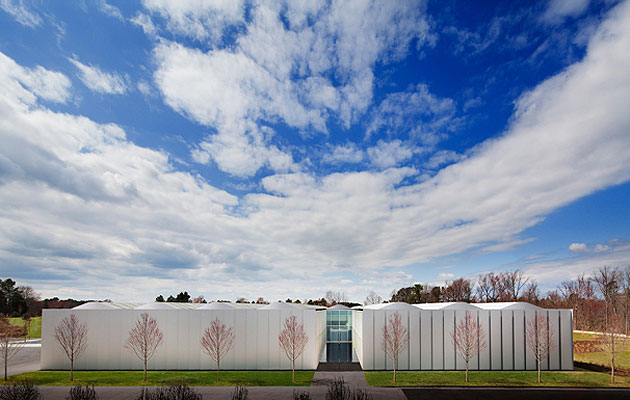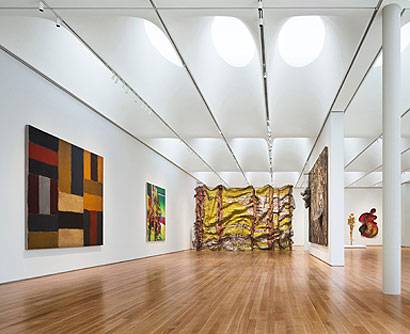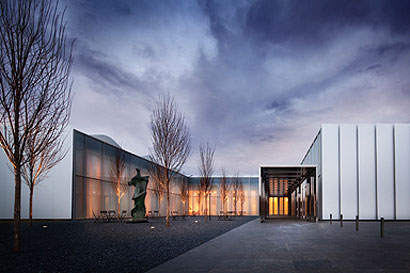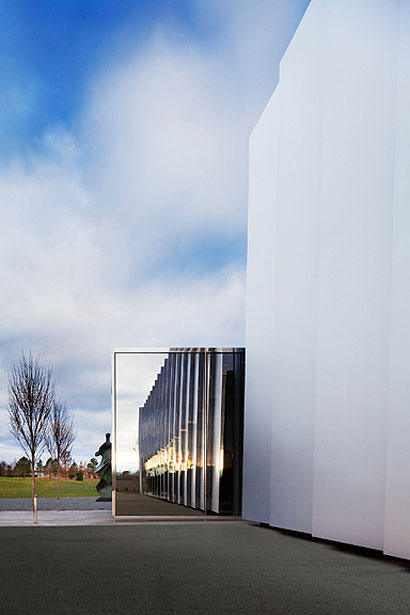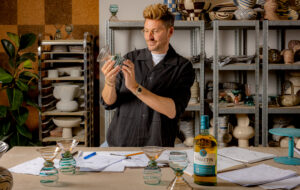|
image: Scott Frances, courtesy the North Carolina Museum of Art |
||
|
Raleigh, North Carolina, has taken a dramatic step towards becoming a cultural centre on a regional or even national level with the reopening of the North Carolina Museum of Art (NCMA) at the end of April. Thomas Phifer, a New York-based Southerner with an award-winning portfolio focusing primarily on residential work, brings world-class design expertise to the Research Triangle area with a sleekly detailed single-storey building. Serenity, transparency, proximity to nature, and purposeful lighting control are the hallmarks of the new NCMA. Phifer’s chief priority at all points is the viewing experience. Penetrating the rectangular plan asymmetrically with five deep courtyards, and admitting ample, evenly distributed daylight via a precisely crafted roof, the building maximises both lateral and overhead light while regulating illumination levels through a range of strategies. These include a system of sensor-controlled shades and scrims responsive to weather and curatorial choices alike. The ceiling comprises 362 identical light-directing units. North-facing rooftop louvres guide sunlight into the galleries through elliptical fabric-filtered oculi. Ceiling coffers while minimising southern light harsh enough to damage artworks. Computerised halogen track lights, their dimmers also coordinated with daylight levels, enhance the atmosphere. The quality of illumination throughout the 6,000sq m gallery area is exceptional: colors pop, and sculptural detail appears finely grained. The building’s cladding consists of anodised aluminium panels set at slight angles, evoking a segmented exoskeleton. At the juncture points, 15cm wide reflective segments of polished stainless steel set at approximate right angle to the main panels create a mirrored pseudo-surface that “disappears” into the surrounding greenery when viewed at a sharp angle. Mirroring effects also distinguish the dramatic entryway, where the play of transparencies and reflections tricks and trains the eye as one approaches the atrium. Set within a 66ha site comprising a sculpture park, four nature trails, a pond with a water-filtration function, and an outdoor theatre (as well as the 1983-vintage East Building by Edward Durell Stone, never fully completed, but now undergoing renovation for educational uses and temporary exhibitions), Phifer’s building follows through on director Larry Wheeler’s description as a “marriage of art and nature.” As marriages go, this one’s more playful than reverent, with recurrent opportunities for Art and Nature to swap roles and invade each other’s territories. The building’s balance of restraint and transparency stresses continuities both within the collection (which includes pieces reaching from ancient Egypt to contemporary art works, with a specialism in Dutch and Flemish painting, Africana, Judaica and a collection of Rodin’s sculptures) and outwardly, with the Raleigh area’s natural and social environment. Phifer describes the design and construction process as “a journey based on curiosity: what was around? How can we express nature here? … Having the light bathe these wonderful works of art in a controlled way really celebrates this extraordinary collection.” Perhaps the most extraordinary feature of the NCMA, making the term “democratic” a substantive principle rather than a bit of curatorial rhetoric, is the admission price: free.
The contemporary gallery un the NCMA. North-facing rooftop louvres guide sunlight into the galleries through elliptical fabric-filtered oculi (image: Scott Frances, courtesy the North Carolina Museum of Art)
Entry façade of the museum. The building’s cladding consists of anodised aluminium panels set at slight angles (image: Scott Frances, courtesy the North Carolina Museum of Art)
image: Scott Frances, courtesy the North Carolina Museum of Art |
Words Bill Millard |
|
|
||

